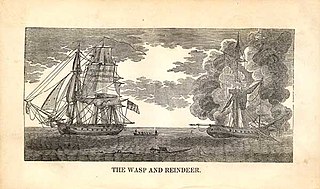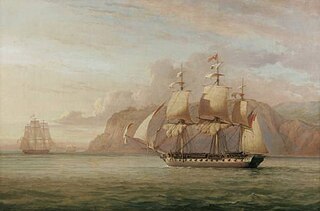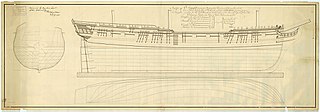Heureux was a 22-gun French privateer brig that the British captured in 1800. She served with the Royal Navy as the 22-gun post ship HMS Heureux. She captured numerous French and Spanish privateers and merchant vessels in the Caribbean Sea before she was lost at sea in 1806. Her fate remains a mystery to this day.

HMS Reindeer was a Royal Navy 18-gun Cruizer-class brig-sloop of the Royal Navy, built by Samuel & Daniel Brent at Rotherhithe and was launched in 1804. She was built of fir, which made for more rapid construction at the expense of durability. Reindeer fought in the Napoleonic Wars before succumbing in 1814 to the guns of USS Wasp during the War of 1812.

Proserpine was a 38-gun Hébé-class frigate of the French Navy launched in 1785 that HMS Dryad captured on 13 June 1796. The Admiralty commissioned Proserpine into the Royal Navy as the fifth rate, HMS Amelia. She spent 20 years in the Royal Navy, participating in numerous actions in the French Revolutionary and Napoleonic Wars, capturing a number of prizes, and serving on anti-smuggling and anti-slavery patrols. Her most notable action was her intense and bloody, but inconclusive, fight in 1813 with the French frigate Aréthuse. Amelia was broken up in December 1816.

HMS Dryad was a fifth-rate sailing frigate of the Royal Navy that served for 64 years, at first during the Napoleonic Wars and then in the suppression of slavery. She fought in a notable single-ship action in 1796 when she captured the French frigate Proserpine, an action that would later earn her crew the Naval General Service Medal. Dryad was broken up at Portsmouth in 1860.

HMS Unicorn was a 32-gun fifth-rate Pallas-class frigate of the Royal Navy, launched in 1794 at Chatham. This frigate served in both the French Revolutionary Wars and the Napoleonic Wars, including a medal action early in her career. She was broken up in 1815.

HMS Spitfire was a Tisiphone-class fireship of the Royal Navy. She served during the years of peace following the end of the American War of Independence, and by the outbreak of the French Revolutionary Wars, had been reclassified as a 14-gun sloop-of-war. Spitfire went on to serve under a number of notable commanders during a successful career that saw her capture a considerable number of French privateers and small naval vessels. She spent most of her career in Home waters, though during the later part of her life she sailed further afield, to the British stations in North America and West Africa. She survived the Napoleonic Wars and was eventually sold in 1825 after a period spent laid up.

HMS Hornet was a 16-gun ship-rigged sloop of the Cormorant class in the Royal Navy, ordered 18 February 1793, built by Marmaduke Stalkart and launched 3 February 1794 at Rotherhithe. Hornet saw most of her active duty during the French Revolutionary Wars. During the Napoleonic Wars she served for about six years as a hospital ship before being laid up in 1811 and sold in 1817.
HMS Hippomenes was a former Dutch corvette built in Vlissingen in 1797 for the Batavian Republic. The British captured her in 1803 and she served with the Royal Navy until sold in 1813. With the Royal Navy she participated in two notable single-ship actions in the West Indies.

HMS Alligator was a 28-gun Enterprise-class sixth rate frigate of the Royal Navy. She was originally ordered during the American War of Independence but was completed too late to see service during the conflict. Instead she had an active career during the French Revolutionary and Napoleonic Wars.

HMS Scorpion was a Royal Navy Cruizer-class brig-sloop built by John King at Dover and launched in 1803. She was the first of the class to be built since the launching of Cruizer in 1797. Scorpion had a long and active career during the Napoleonic Wars, earning her crews three clasps to the Naval General Service Medal when the Admiralty authorized it in 1847, two for single-ship actions. She also took a number of prizes. Scorpion was sold in 1819.
HMS Guachapin was a brig, the former Spanish letter of marque Guachapin, launched at Bayonne in 1800, which the British captured early in 1800 and took into service with the Royal Navy. Under the British flag she captured a Spanish privateer larger and better-armed than herself. She also served at the captures of the islands of St. Bartholomew, St. Martin, St. Thomas, St. Croix, Tobago, and St. Lucia, and of Surinam. She served at Antigua as a guard ship but was wrecked in 1811. She was then salvaged and sold.
HMS Moucheron was a French privateer, built in 1799, that the British captured in 1801. The British government purchased her in 1802 for the Royal Navy. She foundered in 1807 in the Mediterranean without leaving a trace.
HMS Surinam was the 18-gun Batavian corvette or sloop Pilades that the British captured on 5 May 1804 when they captured Surinam from the Dutch. The Batavian flotilla that the British captured was under the command of naval Captain Blots Van Treelong.
HMS Galgo was a Jamaican privateer that the Spanish Navy captured in 1797 and named Galgo Inglés, and that the British captured in November 1799. In her brief career she detained, took, or destroyed a number of small prizes before October 1800, when she foundered, with the loss of most of her crew and passengers.
HMS Unique was the French 12-gun schooner Harmonie that Cyane captured from the French in 1804. A French privateer recaptured and sank Unique in 1806.
The French corvette Robuste was a vessel built at Nantes in 1789 as a slaver that made her first and only slave-trading voyage in 1789-90. The French navy purchased her in December 1793 and she served as a 22-gun corvette in the Channel. The British captured her in 1796 and took her into the Royal Navy as HMS Scourge. She captured a number of French privateers, primarily in the West Indies, before the navy sold her in 1802.

HMSEmerald was a 36-gun Amazon-class fifth rate frigate that Sir William Rule designed in 1794 for the Royal Navy. The Admiralty ordered her construction towards the end of May 1794 and work began the following month at Northfleet dockyard. She was completed on 12 October 1795 and joined Admiral John Jervis's fleet in the Mediterranean.

HMS Rosario was a 20-gun sixth rate of the British Royal Navy. She was previously the French privateer Hardi, which HMS Anson captured in 1800. The navy took her into service as HMS Hardi but renamed her HMS Rosario later in 1800. She was sold in 1809.
HMS Argus was launched in 1798 at Bordeaux as Argus. She became a privateer that the British Royal Navy (RN) captured in 1799. She served from April 1803 until she was broken up in April 1811.
HMS Barbadoes was originally a French privateer and then slave ship named Brave or Braave. A British slave ship captured her in September 1803. In 1803–1804 she became the British privateer Barbadoes for a few months. In 1804 the inhabitants of Barbados purchased her and donated her to the Royal Navy, which took her into service as HMS Barbadoes. She wrecked on 27 September 1812.









